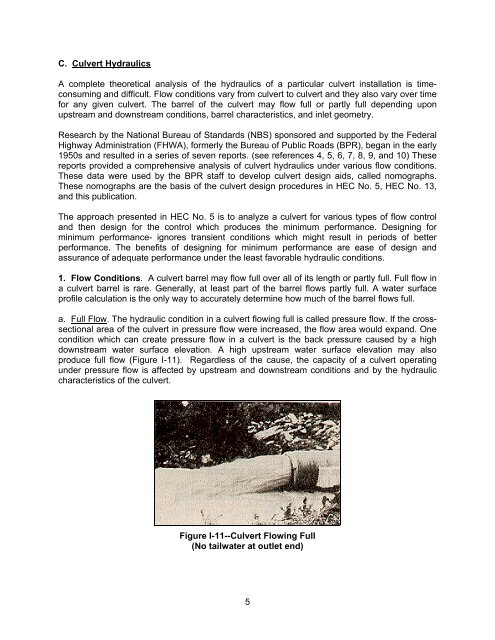Hydraulic Design of Highway Culverts - DOT On-Line Publications
Hydraulic Design of Highway Culverts - DOT On-Line Publications
Hydraulic Design of Highway Culverts - DOT On-Line Publications
You also want an ePaper? Increase the reach of your titles
YUMPU automatically turns print PDFs into web optimized ePapers that Google loves.
C. Culvert <strong>Hydraulic</strong>s<br />
A complete theoretical analysis <strong>of</strong> the hydraulics <strong>of</strong> a particular culvert installation is timeconsuming<br />
and difficult. Flow conditions vary from culvert to culvert and they also vary over time<br />
for any given culvert. The barrel <strong>of</strong> the culvert may flow full or partly full depending upon<br />
upstream and downstream conditions, barrel characteristics, and inlet geometry.<br />
Research by the National Bureau <strong>of</strong> Standards (NBS) sponsored and supported by the Federal<br />
<strong>Highway</strong> Administration (FHWA), formerly the Bureau <strong>of</strong> Public Roads (BPR), began in the early<br />
1950s and resulted in a series <strong>of</strong> seven reports. (see references 4, 5, 6, 7, 8, 9, and 10) These<br />
reports provided a comprehensive analysis <strong>of</strong> culvert hydraulics under various flow conditions.<br />
These data were used by the BPR staff to develop culvert design aids, called nomographs.<br />
These nomographs are the basis <strong>of</strong> the culvert design procedures in HEC No. 5, HEC No. 13,<br />
and this publication.<br />
The approach presented in HEC No. 5 is to analyze a culvert for various types <strong>of</strong> flow control<br />
and then design for the control which produces the minimum performance. <strong>Design</strong>ing for<br />
minimum performance- ignores transient conditions which might result in periods <strong>of</strong> better<br />
performance. The benefits <strong>of</strong> designing for minimum performance are ease <strong>of</strong> design and<br />
assurance <strong>of</strong> adequate performance under the least favorable hydraulic conditions.<br />
1. Flow Conditions. A culvert barrel may flow full over all <strong>of</strong> its length or partly full. Full flow in<br />
a culvert barrel is rare. Generally, at least part <strong>of</strong> the barrel flows partly full. A water surface<br />
pr<strong>of</strong>ile calculation is the only way to accurately determine how much <strong>of</strong> the barrel flows full.<br />
a. Full Flow. The hydraulic condition in a culvert flowing full is called pressure flow. If the crosssectional<br />
area <strong>of</strong> the culvert in pressure flow were increased, the flow area would expand. <strong>On</strong>e<br />
condition which can create pressure flow in a culvert is the back pressure caused by a high<br />
downstream water surface elevation. A high upstream water surface elevation may also<br />
produce full flow (Figure I-11). Regardless <strong>of</strong> the cause, the capacity <strong>of</strong> a culvert operating<br />
under pressure flow is affected by upstream and downstream conditions and by the hydraulic<br />
characteristics <strong>of</strong> the culvert.<br />
Figure I-11--Culvert Flowing Full<br />
(No tailwater at outlet end)<br />
5

















